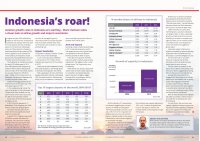Sri Lanka has experienced a tourism boom since its civil war officially ended five years ago. Its flag carrier’s chief executive officer, Kapila Chandrasena, outlined the plan for the next five years to Martin Rivers for our sister publication Routes News.
When Sri Lanka’s 25-year-long civil war ended in May 2009, the government placed tourism at the heart of its economic recovery. This has paid dividends, with visitor numbers almost tripling since the guns fell silent, with 1.27 million tourists last year rediscovering the island’s pristine beaches and wildlife resorts.
Much of the growth has been driven by SriLankan Airlines, which increased its traffic 55 per cent between 2009 and 2013. The loss-making flag carrier is not, however, solely focused on the top line as chief executive officer, Kapila Chandrasena, has also committed to a five-year turnaround plan, and he sees upcoming oneworld alliance membership as the best vehicle for growing sustainably.
“Our task right now is to consolidate and make the routes we serve profitable,” he said. “On the one hand we have to expand our network. On the other hand we need to keep very close control of our cost base, if we are going to at least recover costs and reach break-even.”
SriLankan Airlines last week announced it will officially join oneworld on May 1, 2014, having delayed its entry to allow time for IT integration. The airline already codeshares with three oneworld members – Malaysia Airlines, Royal Jordanian Airlines and Russia’s S7 Airlines – but Chandrasena sees scope for deeper ties, particularly with some of the alliance’s larger members.
“What oneworld brings is it gives us the network reach,” Chandrasena explained. “Right now we are servicing 62 destinations. Overnight it will be close to 800 destinations. There will be more codeshares with our alliance partners.”
At the same time, Chandrasena acknowledged that his future oneworld affiliates will have expectations of their own – “It’s not only about what we can gain from the alliance, but also what we can offer the alliance” – so the business plan also explores new paradigms for developing capital city Colombo as a hub.
SriLankan Airlines’ network focuses heavily on South Asia, with more than 80 weekly flights to eight cities in India, and more than 30 to the Maldives. About 150 weekly flights between eight domestic destinations are also operated by the mainline Airbus fleet plus subsidiary SriLankan Air Taxi’s Cessna Caravans.
The flag carrier’s strong regional foothold is its main offering to oneworld, which Chandrasena said has a “bit of a vacuum” in South Asia. As well as providing 60 per cent of all flights to Sri Lanka, he described the airline as the “de facto main carrier for the Maldives”. But, in order to strengthen its hub-and-spoke model, long-haul traffic flows must now be optimised alongside the carrier’s new partners.
SriLankan Airlines serves five cities in Europe (London, Paris, Frankfurt, Rome and Moscow), and eight in the Far East (Tokyo, Beijing, Shanghai, Guangzhou, Hong Kong, Bangkok, Kuala Lumpur and Singapore). It also has a sizable presence in the Middle East, and operates daily flights to Karachi in Pakistan.
Oneworld members British Airways, airberlin and S7 Airlines will give the carrier a “broader footprint in Europe”, Chandrasena said, enticing more holidaymakers to Sri Lanka. Synchronising schedules to ease the transfer of traffic between affiliates will be the first step. With the immediate focus on non-organic growth, new routes in Europe are largely off the agenda.
“We decided to take capacity expansion up-front in year one and year two of the business plan,” the chief executive noted, referring to the airline’s post-war network growth. “Now is the time for stabilising those routes. What you will see is tweaking of the network, increasing frequencies, and working towards daily flights on all the destinations we serve. Any new destinations are decided on a stand-alone commercial basis,” he reiterates. “In that sense I don’t see much of a change… I think we have the right coverage to feed the rest of Europe.”
Despite the cautious approach, however, Europe remains a critical market for SriLankan Airlines. Some 137,000 British tourists visited Sri Lanka last year, making it the second highest source of tourism behind India. The airline’s 12 weekly flights to London Heathrow account for more than a quarter of its capacity when measured by available seat kilometres.
Further afield, SriLankan Airlines is reviewing its US connections ahead of possible codeshares with oneworld’s American Airlines. Given that the US is located on the opposite side of the globe, “both Atlantic and Pacific” routings are viable for flights, according to the chief executive. The flag carrier currently swaps codes with Etihad Airways westwards and Malaysia Airlines eastwards. It also serves two other oneworld hubs in Asia – Cathay Pacific’s Hong Kong, and Japan Airlines’ Tokyo, which raises the prospect of codeshare revisions or even new fifth-freedom services.
“Certainly Cathay is our sponsor to oneworld, and we are working very closely [with them],” the chief executive hinted. “We see potential synergies because they are very strong in Asia and the US and Canada, and they are servicing Colombo.” He added that Malaysia Airlines also flies to Colombo, with Kuala Lumpur functioning as a springboard for Australia. “We are looking at all 13 members to really leverage the partnerships,” Chandrasena emphasised. “Some networks offer greater opportunity than others.”
While its network planners hammer out the most prudent oneworld arrangements, SriLankan Airlines is also grappling over how best to expand in China. The flag carrier already flies to Beijing, Shanghai, Guangzhou and Hong Kong, and is keen to tap into more emerging markets. However, modest origin-and-destination traffic from China to Sri Lanka has until recently necessitated stopovers in Bangkok on all four routes, with Beijing and Shanghai being upgraded to non-stop services in March.
Only one in 10 passengers flying with the carrier from China actually sets foot in Colombo, with most either disembarking in Thailand or continuing on to the Maldives. “Right now we offer Colombo and Malé [the Maldivian capital] for the Chinese. I think this can be scaled up,” Chandrasena began. “China is an enabling market for us. It’s a growing market, and we have a clean sheet approach.”
Attracting more Chinese passengers will again require SriLankan Airlines to develop its hub model. But unlike the regional proposition that benefits oneworld, Chinese travellers are likely to continue their journeys further west to Africa. Chinese enterprises provide more than $30 billion of capital inflows to the continent each year, with annual trade between the two sides ballooning from $10 billion at the turn of the century to about $200 billion in 2012.
“We see major high-volume traffic flows between Asia and Africa, and especially China and Africa, given the Chinese investment in the continent,” Chandrasena explained. For now, efforts to capitalise on this geographical advantage are largely at the “market evaluation and modelling stage”.
SriLankan Airlines has yet to launch any routes to Africa (although low-cost sister carrier Mihin Lanka recently added flights to the Seychelles, off Africa’s east coast). Chandrasena said the priority is ensuring any push into the continent is supported by “commercial realities”.
“It’s not realistic for me to say we’ll serve ten points in Africa,” he conceded. “But, certainly one or two major points. We will look at some type of partnership or alliance within Africa, in order to fan out across the continent.”
Sri Lanka’s President, Mahinda Rajapaksa, made state visits to South Africa and Kenya in late 2013, and “fairly high-level discussions” have also been held with Tanzanian authorities. Sri Lanka may, however, face an uphill struggle in convincing an African partner to collaborate.
Kenya Airways already codeshares with China Eastern Airlines and China Southern Airlines; South African Airways is moving ever closer to Etihad; and Tanzania’s biggest airline, Precision Air, itself part-owned by Kenya Airways, has almost no international routes. “The markets we serve are very competitive, so we have to be very smart in what we do,” Chandrasena said of the wider landscape. “But we are making the right decisions, and the signs so far are encouraging.”
His optimism appears to be matched by shareholder the Sri Lankan government. Colombo has already injected $225 million into the flag carrier over the past two years, and bridging facilities for a further $275 million are now being arranged. Much of the financing is going towards an upcoming fleet renewal. The flag carrier will receive six Airbus A330-300s between October 2014 and the end of 2015, allowing it to replace its existing A340s. Seven A350s will then start arriving in 2017, paving the way for the eventual replacement of its existing A330-200s.
On the narrowbody front, two of the airline’s eight A320s will be replaced with leased A321s in 2014. “The next replacements will be the A321neos,” Chandrasena said, alluding to subsequent long-term orders. Mihin Lanka also operates two A321s and one A320, and will receive two Boeing 737-800s in 2015.
Despite deepening its losses to 21.8 billion rupees ($171 million) in the 2012 fiscal year, SriLankan Airlines’ net margin has improved. The country’s target of attracting 2.5 million tourists by 2016 is ambitious, but will be buoyed by an improving global economy. With oneworld also delivering synergies, the flag carrier is hopeful of entering the black around 2017. That would mark the first time it has been profitable since 2007, when the global financial crisis struck and Sri Lanka’s civil war intensified.
“I’m really optimistic about the future of Sri Lanka. I think it’s going in the right direction,” Chandrasena concluded. “As a national carrier we have to provide the leadership and drive the growth. We are very challenged and encouraged with this opportunity.”
Footnote: SriLankan Airlines will become a full member of oneworld, offering the alliance’s complete range of services and benefits with effect from Thursday May 1, 2014 – as the first carrier from the Indian subcontinent to become part of any global airline groups. The national airline of Sri Lanka received clearance to board oneworld, the world’s leading quality airline alliance, after successfully completing a thorough review of its readiness conducted by Cathay Pacific Airways, which is sponsoring its entry into the alliance, with the oneworld central team. Its addition to oneworld will come a month after the alliance welcomes TAM Airlines and US Airways on board, on March 31, 2014, concluding the group’s biggest yet expansion programme. Its addition will bring two new destinations on to the oneworld network – Sri Lanka’s new Hambantota International and India’s Tiruchirapalli.
 |
DON'T MISS the latest issue of Routes News which is available at this year's Routes Asia and includes an EXCLUSIVE report on the Indonesian aviation industry. |  |





